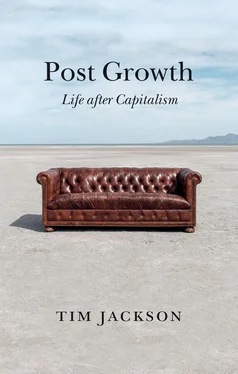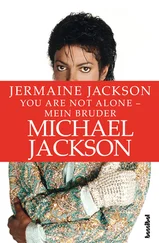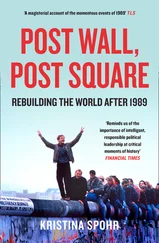11 11. Historical data on GDP and growth rates can be found in the World Bank’s World Development Indicators Databank, online at: https://databank.worldbank.org/source/world-development-indicators.
12 12. Critique of growth: d’Alisa et al. 2014; Jackson 2017; Kallis et al. 2020; Raworth 2017; Trebeck and Williams 2019; Victor 2019.
13 13. On JFK, Carson and Douglas see: https://www.audubon.org/magazine/may-june-2012/rachel-carson-and-jfk-environmental-tag-team.
14 14. See Introduction to Galbraith 1958, p. xi.
15 15. Schlesinger 1956, p. 10.
16 16. EU: https://ec.europa.eu/environment/beyond_gdp/background_en.html. OECD: https://www.oecd.org/statistics/measuring-economic-social-progress/. World Economic Forum: https://www.weforum.org/agenda/2020/01/gdp-alternatives-growth-change-economic-development/. Lunatics etc.: see Jackson 2017, p. 21. Prime Ministers: https://www.gov.uk/government/speeches/pm-speech-on-wellbeing.
17 17. For an overview, see Corlet Walker and Jackson 2019. See also: Kubiszewski et al. 2013; https://treasury.govt.nz/information-and-services/nz-economy/higher-living-standards/our-living-standards-framework.
18 18. Stiglitz: https://www.theguardian.com/commentisfree/2019/nov/24/metrics-gdp-economic-performance-social-progress.
19 19. Daly 1968. For a discussion of the paper – and the circumstances of publication – see Victor 2021, Chapter 4.
20 20. Daly’s work was also influenced by his doctoral supervisor, the Romanian-born mathematician Nicholas Georgescu-Roegen, who at that point was preoccupied with the fundamentally ‘entropic’ nature of the economy as a thermodynamic system. More of that in Chapter 5.
21 21. Ecological economics: Common and Stagl 2005; Costanza 1991; Daly and Cobb 1989; Daly and Farley 2011; Martinez-Alier 1991. See also the journal Ecological Economics: https://www.journals.elsevier.com/ecological-economics. Steady state: Daly 1974, pp. 15–16; see also Daly 1977; 2014.
22 22. Mill 1848, p. 593.
23 23. Kennedy’s shooting, see Newfield 1969, pp. 289–304. See also: http://jfk.hood.edu/Collection/Weisberg%20Subject%20Index%20Files/K%20Disk/Kennedy%20Robert%20F%20Assassination%20Clips/Item%20054.pdf.
‘As a capitalist, I believe it’s time to say out loud what we all know to be true: Capitalism, as we know it, is dead.’
Marc Benioff, 2019 1
‘Shamed, dishonoured, wading in blood and dripping with filth, thus capitalist society stands.’
Rosa Luxemburg, 1915 2
In a curious incident, during the run-up to the 2016 Brexit Referendum in the UK, a British academic was trying to persuade a public meeting of the dangers awaiting the country if it cast itself adrift from membership of the European Union. The impact on the GDP would dwarf any savings the UK might make from its budget contributions to the EU, the expert told the crowd. ‘That’s your bloody GDP!’ shouted a woman in the audience. ‘It’s not ours!’ 3
Behind this angry remark lay a host of uncomfortable truths. That almost a decade after the financial crisis, economic growth had failed to return to its pre-crisis trend. That successive years of austerity had made the lives of the poorest harsher. That faith in the expertise of economists and politicians had been severely eroded along the way. That statistics had become weaponized in the interests of elite minorities. That, in a ‘post-truth’ era, numbers themselves no longer held sway as immutable facts. 4
But above all, the anger betrayed an undeniable sense of loss: a loss of faith in the myth of growth. The continual expansion of the economy – growth in the GDP – had been synonymous with the idea of social progress for as long as anyone could remember. But that cosy idea no longer reflected the reality of everyday life for ordinary people in one of the most advanced economies of the world. Beyond the fury of the crowd lay the discernible rumbling of a cultural myth beginning to fall apart.
Strangely, that loss of faith wasn’t just confined to those left behind by the economic system. It has appeared in the most unlikely places. Sometimes at the heart of the establishment. A walk-on part for the postgrowth society was not the only evidence that things were changing in Davos. One of the world’s largest banks chose the 2020 World Economic Forum to hold a week-long series of discussions under the title ‘Is Growth an Illusion?’ 5
It had been a bad year (indeed a difficult decade) for Deutsche Bank. Rocked by controversy over its financial dealings with the Trump empire and still recovering from litigation settlements which dated from before the financial crisis, it had posted two consecutive quarters of substantial losses immediately prior to Davos. Its $1.4 trillion assets still placed it as the seventeenth largest bank in the world in 2020. But those assets had fallen dramatically from a pre-crisis peak of $3.6 trillion. Growth was almost literally an illusion for the ailing giant. 6
It has been increasingly elusive for the advanced economies as a whole. The 5% growth rates typical of the US economy in 1968 are now long gone. By the start of 2020, even before the pandemic, the average rate of growth across the OECD nations was barely 2%. If we measure the average growth rate per person over these periods – a better indicator of what economists call living standards – the decline is even more obvious. And if we measure ‘labour productivity’ – the average output generated per hour worked in the economy – then things look worse again. 7
In the UK, the oldest of the developed economies, the picture is particularly striking. From a peak of around 4% in 1968, the trend growth in labour productivity had already fallen to less than 1% before the financial crisis in 2008. In the aftermath, its descent continued. In the years before the coronavirus crisis, there was virtually no growth in labour productivity at all. Sometimes – most strikingly through the pandemic – productivity growth went into reverse. Labour productivity declined in absolute terms across the economy as a whole. 8
These trends matter. It’s only possible to squeeze GDP growth out of an economy with stationary or declining labour productivity by increasing the hours spent working there. Either more people must work or else each of them must work longer hours. Neither of these things is consistent with the promise that capitalism held out to us. Once labour productivity growth goes into reverse, in fact, we are already to all intents and purposes living in a postgrowth world. Figuring out how to survive – let alone flourish – under these circumstances is no longer trivial.
For the most part, economists don’t try. They either deny the reality of these trends or else they assume we can somehow turn the ship around and return to the good old days. A sense of anxiety pervades this denial. Davos was full of it. ‘Deep new rifts are tearing apart the fabric of our societies,’ warned the development economist Paul Collier, because ‘Capitalism’s core credential of steadily rising living standards for all has been tarnished.’ The very next day, it was the turn of billionaire Marc Benioff, Chair and co-CEO of Salesforce. ‘Capitalism as we have known it is dead,’ he lamented. 9
The air of bemusement was palpable. Not that long ago, things were going so well. Living standards were rising; democracy was thriving; freedom – the buzzword of western liberalism – abounded. And with the fall of the Iron Curtain, political opposition to the dominant economic model seemed to have faded away. Capitalism could deliver all the progress we ever needed. The political scientist Francis Fukuyama was even persuaded to declare that we’ve reached ‘the end of history’: the pinnacle of humanity’s ideological evolution. 10
Читать дальше












